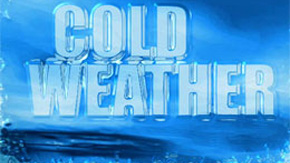Freezing Weather — Protecting Pets, Plants, Pipes And Other Tips
January 29, 2019
 When temperatures fall into the teens and hard freeze warning, it is time to take necessary precautions to protect pipes, pets and plants, and check on elderly friends and neighbors.
When temperatures fall into the teens and hard freeze warning, it is time to take necessary precautions to protect pipes, pets and plants, and check on elderly friends and neighbors.
For tonight’s latest forecast, click here.
Here are ways to stay safe during this year’s first round of cold temperatures, courtesy of the American Red Cross:
- Wear layers of lightweight clothing to stay warm. Gloves and a hat will help prevent losing body heat.
- Know the signs of hypothermia — confusion, dizziness, exhaustion and severe shivering. If someone has these symptoms, they should get immediate medical attention.
- Watch for symptoms of frostbite including numbness, flushed gray, white, blue or yellow skin discoloration, numbness or waxy feeling skin.
- Bring the pets indoors. If that’s not possible, make sure they have enough shelter to keep them warm and that they can get to unfrozen water.
- Avoid frozen pipes — run water, even at a trickle, to help prevent them from freezing. Keep the thermostat at the same temperature day and night to help avoid freezing pipes.
- Do not use a stove or oven to heat the home.
- Space heaters should sit on a level, hard surface and anything flammable should be kept at least three feet away.
- If using a fireplace, use a glass or metal fire screen large enough to catch sparks and rolling logs.
- Turn off space heaters and make sure fireplace embers are out before leaving the room or going to bed.
And here are a few extra details and tips from ECUA on protecting pipes against the freeze:
- Insulate pipes or faucets in unheated areas: Pipes located in unheated areas of your house, such as a garage or crawl space under the house or in the attic, are subject to freezing. If you have time to do this before freezing temperatures arrive, wrap these pipes with insulation materials made especially for this purpose. These materials can be found in most hardware stores or home improvement centers.
- Disconnect and drain outdoor hoses: Detach all hoses from faucets and allow them to drain. This action guards against the water in the hose or pipe from freezing and bursting the faucet or pipe to which it is connected.
- Run a trickle of water: When forecasts call for sustained and / or severe freezing temperatures, run a thin trickle of water from the faucet furthest from the water line coming to your house. Usually this is in a room at the back of the house or outside, in the yard. Allowing the water to circulate through your home’s plumbing helps to keep it from freezing. Some consider this a waste of water but the cost of the water used is extremely slight compared to repairing broken pipes and the resulting water damage.
- Remember the backflow preventer: Residents and business owners who have backflow preventers on their properties for water lines, fire lines, irrigation systems, and swimming pools need to protect their backflow preventers from freeze as well. Extended freezes can burst the body of the backflow assembly, rendering it useless. Wrap these pipes with insulation materials, made especially for this purpose. These materials can be found in most hardware stores or home improvement centers. If the device and the water line are not in use at this time (i.e., irrigation system or swimming pool lines), shut off the water supply line and drain the backflow device.
Comments
2 Responses to “Freezing Weather — Protecting Pets, Plants, Pipes And Other Tips”



Good J.M. and look at it like this….
If your cold…. they are cold
In addition to the suggestion for pets, consider pine straw, wood shavings, or blankets for bedding, make sure wind cannot get to them, like using a tarp, and see to it that their shelter will remain dry if it rains. Make sure they have access to fresh water and hearty food. Remember, they’re a lot like us, they get cold, thirsty, and hungry, and need companionship too.